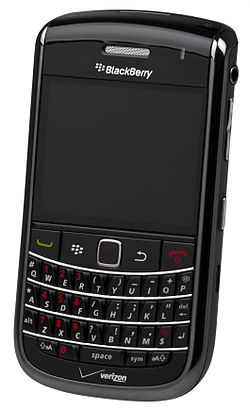This article needs additional citations for verification .(May 2023) |
| | |
| Manufacturer | Research In Motion |
|---|---|
| Availability by region | 2008–2013 |
| Predecessor | BlackBerry Curve 8330 BlackBerry 8800/8830 |
| Successor | BlackBerry Q10 BlackBerry Classic BlackBerry Z10 |
| Operating system | BlackBerry OS |
| Data inputs | QWERTY |
| Development status | Discontinued |
The BlackBerry Bold was a line of mid-range and high-end smartphones developed by BlackBerry Limited. The lineup was launched in 2008 with the BlackBerry Bold 9000, originally a flagship BlackBerry device before the introduction of the BlackBerry Storm. In 2009, the form factor was made more compact with the 9700 and the 9630. In 2010, the 9650 and 9780 were released with BlackBerry OS 6. In 2011, the 9780 was replaced by the 9790/9788 alongside the 9900/9930 series. The 9900/9930 and 9790, which have additional touchscreen displays, released in August and November 2011, respectively.
Contents
- Early series
- BlackBerry Bold 9700
- BlackBerry Bold 9650
- BlackBerry Bold 9780 Series
- BlackBerry 7 series
- BlackBerry Bold 9900/9930
- BlackBerry Bold 9790
- Model comparison
- Early series 2
- BlackBerry 7 series 2
- References
- External links
The Bold family was known for its distinctive form factor, QWERTY keyboard, and typical BlackBerry messaging capabilities with a different keyboard design than the Curve and Pearl series. The Bold series was usually more expensive and had more expensive materials (e.g. leather, soft touch rubber, carbon fiber, metal) compared to the Curve (plastic, glossy), and had higher specifications. There were two basic form factors within the Bold line: the original larger size on the 9000 and 9900, and the compact form factor of the other models.






